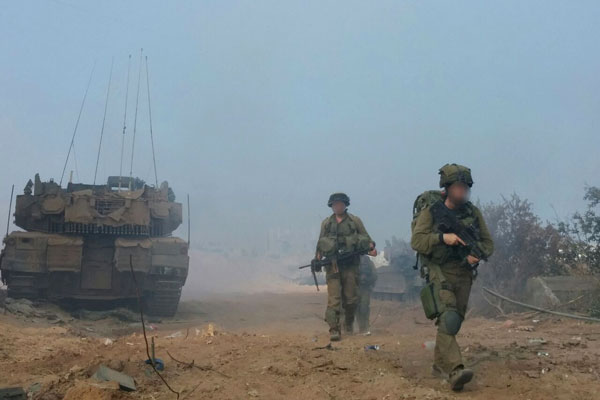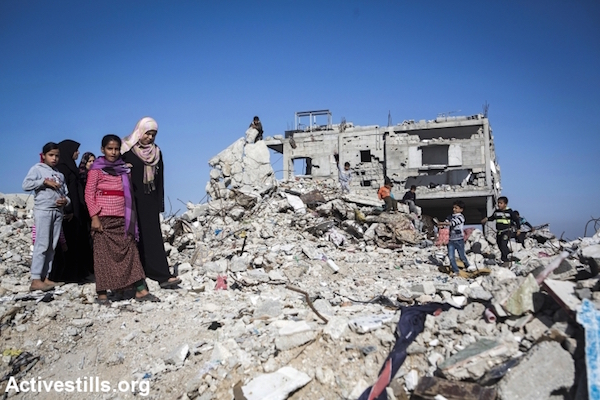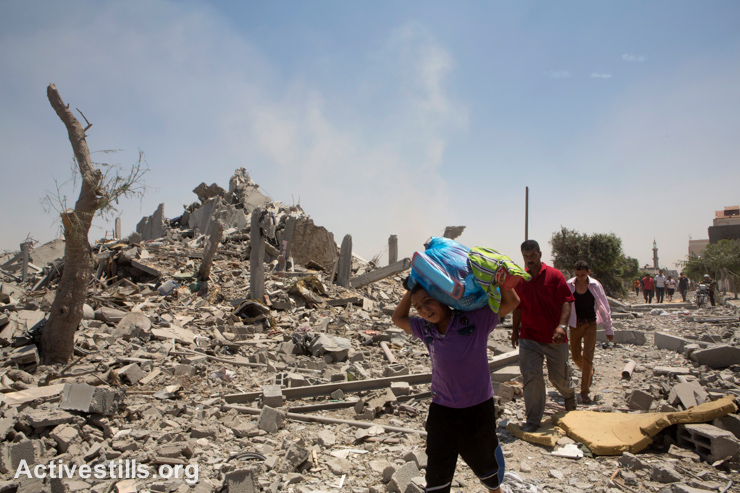Two themes are present in almost all of the 60-plus testimonies collected by Breaking the Silence from Israeli soldiers who fought in the last Gaza war: loose rules of engagement and systematic, wanton destruction. But can the new documentation serve as a catalyst for change inside Israel? Internationally?
By Mairav Zonszein and Michael Schaeffer Omer-Man

Breaking the Silence, an Israeli organization of military veterans, released on Monday a collection of testimonies from nearly 70 soldiers and officers who participated in Operation Protective Edge in the Gaza Strip last summer.
It has been 10 months since the 50-day assault, which killed over 2,000 Palestinians, injured over 11,000, damaged or destroyed over 18,000 residential units and left more than 100,000 people homeless.
While the public debate in Israel has been all but silent regarding the operation, individual soldiers and officers began breaking their silence almost immediately after the final cease-fire went into effect.
Reading through the 136 pages of testimonies from soldiers and officers from nearly every involved division and brigade, two common denominators quickly become apparent. First is the massive, intentional and unnecessary destruction of homes and buildings throughout the Strip, but particularly in places that ground troops set foot.
One of the high rank commanders, he really liked the D9s [armored bulldozers]. He was a real proponent of flattening things. He put them to good use. Let’s just say that after every time he was somewhere, all the infrastructure around the buildings was totally destroyed, almost every house had gotten a shell through it. He was very much in favor of that
— Testimony #37
The second theme, central to nearly every testimony collected from nearly every unit involved in the fighting, was the massive volume and scope of fire employed.
The soldiers’ testimonies point — explicitly and implicitly — to an extremely lenient open-fire policy.
“If you spot someone, shoot.”
“They told us: ‘There aren’t supposed to be any civilians there’.”
“If you shoot someone in Gaza it’s cool, no big deal. First of all, because it’s Gaza, and second, because that’s warfare.”
— Testimony #17
According to estimates provided to and reached independently by Breaking the Silence, at least 35,000 artillery shells were fired during the operation. (Read more here on the use of artillery and “statistical weapons” in Gaza’s urban areas.)
Many soldiers describe the working assumption they were given by their commanders before entering Gaza: everyone is suspicious; no one in the combat zone is innocent.
Ahead of its ground assaults, the IDF dropped flyers from the air, shelled incessantly and even made phone calls to warn Palestinian civilians of the impending assault. The principle was that after such a warning, anyone who remained in that area was surely a terrorist.

The problems with that type of combat doctrine are too many to list, but here are two anyway. Firstly, there may very well be legitimate reasons why an innocent civilian would choose to stay in their home despite a warning, and many more reasons why an innocent civilian might not be able to leave, or have anywhere to go. Secondly, international humanitarian law does not allow for the reclassification of civilians as combatants simply because they did not heed a warning.
“If it looks like a man, shoot. It was simple: You’re in a motherfucking combat zone. A few hours before you went in the whole area was bombed, if there’s anyone there who doesn’t clearly look innocent, you apparently need to shoot that person.”
— Testimony #56
The official IDF rules of engagement normally require a soldier to identify weapon, intent and capability before opening fire, and often they need to get authorization from someone higher up. In many of the cases described in the testimonies, soldiers simply shot immediately at anything that moved.
In one case two women in their 30s were spotted walking through an orchard and gunned down. Even though no weapons were found on their bodies, the soldiers still classified them after the fact as terrorists. (Testimony 35)
A person seen in a window, or walking near the wall of a building, was automatically deemed suspicious and fired on. In some cases, these figures later turned out to be animals, or inanimate objects that had blown in the wind. (Testimonies 24 and 43)
In a number of cases soldiers positioned inside tanks were instructed to shoot off a shell or their heavy machine gun every 30 minutes or an hour, for the entire time they were deployed in Gaza. Sometimes the point was to make sure the Palestinians didn’t forget they were there; other times it was just to make sure the tank crew didn’t nod off for too long. (Testimony 32)

The testimonies tell the story of a calculated war doctrine, the guiding principal of which was to go in with as much force as possible in order to minimize Israeli military casualties — even when there was certainty that it meant harming Palestinian civilians, their property and civil infrastructure. Minimum risk.
That doctrine is evident from the results of the warfare, and from testimonies by Palestinians and human rights investigators. The testimonies collected by Breaking the Silence corroborate and even add a deeper understanding of those conclusions.
Neither of the phenomena revealed through the testimonies — massive destruction and minimal IDF casualties — are new. Tracing back through Israel’s contemporary military history from the First Lebanon War, Operation Defensive Shield in the West Bank, the pullout from southern Lebanon and the Gaza Strip, the Second Lebanon War and most recently, operations Cast Lead and Pillar of Defense, the slow but steady evolution in military doctrine is visible: minimum Israeli military casualties with a corresponding increasing level of acceptable deaths among non-Israeli civilians. Massive bombardments and intentional destruction was seen, incrementally increasing, in Beirut in 2006, Gaza in 2008-9, and ultimately reaching its zenith in Gaza this past summer.
The testimonies, and the indications they give regarding the way Israel approaches guerrilla urban warfare as well as terrorist threats and challenges, tell a story about Israel’s political and military leaders, and about Israeli society. The political and military leadership does not have a solution to its Gaza problem. A strategy that used to be called “mowing the lawn” is no longer enough — the growing levels of destruction are never enough to create any sustainable deterrence, and the diplomatic risk corresponds to Israel’s increasing levels of violence.
Another story told by the testimonies, which admittedly are only excerpts of the full statements and interviews from the soldiers, show a level of apathy toward the “enemy population” that one expects to hear from combatants of any army, but which directly challenges the mythology of the IDF as the “most moral army in the world.” A parallel phenomenon is the role Israeli society plays in the changes to the IDF’s moral calculations and war doctrine. Once upon a time, following the Sabra and Shatila massacre, Israeli society set the boundaries of what it would accept from its military — its peoples’ army. This past summer, the Israeli media systematically refused to even acknowledge the destruction the army was wreaking in Gaza, and anti-war protests were met with violent counter-protests the likes of which hadn’t been seen in decades.
There has been no shortage of testimonies from Palestinian civilians about the horrors that rained down on Gaza this past summer (read here and watch here, for example). And while the Israeli perspective is far-too-often given disproportionate weight — or an exclusive platform — in relation to the Palestinian conflict, these testimonies nevertheless serve a crucial role, both within Israeli society and internationally.
Perhaps as an inherent consequence of the conflict, neither Israelis nor Palestinians tend to believe the other side’s narrative and even their “facts.” So the fact that Israelis, Israeli soldiers, are telling their own society what was done in their name, is vital if there is ever to be an internal movement for change, and certainly if there is ever to be any reconciliation process.
Externally, for those Palestinians seeking justice, the testimonies could ultimately play a significant role in legal redress for any alleged war crimes. In a Haaretz interview with legal scholar Aeyal Gross last week, ICC Prosecutor Fatou Bensouda said that her office’s current preliminary examination process into the Gaza war, “will proceed on the basis of available reliable information. We will be looking at all credible and reliable sources of information.” And although the Israeli military censor compelled Breaking the Silence to remove any identifying information from its testimonies, their credibility and detail could still prove invaluable should an international criminal investigation be initiated.
Read the full report here.


